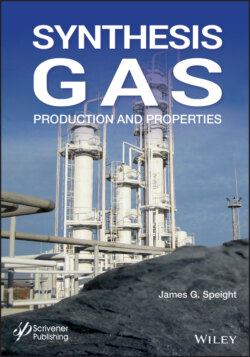Читать книгу Synthesis Gas - James Speight G., James G. Speight - Страница 57
2.6 Products
ОглавлениеThe original concept of the gasification process was to produce a fuel gas for use in homes (including street lighting) and industrial operations. Thus, the gasification of carbonaceous residues is generally aimed to feedstock conversion to gaseous products. In fact, gasification offers one of the most versatile methods (with a reduced environmental impact with respect to combustion) to convert carbonaceous feedstocks into electricity, hydrogen, and other valuable energy products. Depending on the previously described type of gasifier (e.g. air-blown, enriched oxygen-blown) and the operating conditions, gasification can be used to produce a fuel gas that is suitable for several applications.
Gasification agents are typically air, oxygen-enriched air or oxygen and the products of the combustion or gasification oxidation reaction change significantly as the oxygen-to-fuel ratio changes from combustion to gasification conditions, which are dependent upon gasifier design and operation (Luque and Speight, 2015). The mixture under gasifying conditions is fuel-rich and there is not enough oxygen to effect complete conversion of the feedstock, in terms of gas quality. As a result, the feedstock carbon reacts to produce carbon instead of carbon dioxide and the feedstock hydrogen is converted to hydrogen rather than to water. Thus, the quantity and quality of the gas generated in a gasification reactor is influenced not only by the feedstock characteristics but predominantly by the gasifier type and configuration well as by the amount of air, oxygen or steam introduced into the system, which is also influence by the configuration of the gasifier.
At the same time, the fate of the nitrogen and sulfur in the fuel is also dictated by oxygen availability (i.e., the configuration of the gasification reactor). The nitrogen and sulfur in a gasification process has important and environmental consequences. Instead of being converted to the respective oxides, the fuel-bound nitrogen is predominantly converted to molecular nitrogen (N2) and hydrogen cyanide (HCN) while the sulfur in the fuel produces hydrogen cyanide (HCN) and carbonyl sulfide (COS).
Steam is sometimes added for temperature control, heating value enhancement or to permit the use of external heat (allothermal gasification). The major chemical reactions break and oxidize hydrocarbon derivatives to give a product gas of carbon monoxide (CO), carbon dioxide (CO2), hydrogen (H2), and water (H2O). Other important components include hydrogen sulfide (H2S), various compounds of sulfur and carbon, ammonia, low molecular weight hydrocarbon derivatives, and tar.
As a very general rule of thumb, optimum gas yields and gas quality are obtained at operating temperatures of approximately 595 to 650oC (1100 to 1200oF). A gaseous product with a higher heat content (BTU/ft.3) can be obtained at lower system temperatures but the overall yield of gas (determined as the fuel-to-gas ratio) is reduced by the unburned portion of the feedstock, which usually appears as char.
Gasification for electric power generation enables the use of a common technology in modern gas-fired power plants (combined cycle) to recover more of the energy released by burning the fuel. The use of these two types of turbines in the combined cycle system involves (i) a combustion turbine and (ii) a steam turbine. The increased efficiency of the combined cycle for electrical power generation results in a 50% v/v decrease in carbon dioxide emissions compared to conventional coal plants. Gasification units could be modified to further reduce their climate change impact because a large part of the carbon dioxide generated can be separated from the other product gas before combustion (for example carbon dioxide can be separated/sequestered from gaseous byproducts by using adsorbents (e.g., MOFs) to prevent its release to the atmosphere).
Gasification has also been considered for many years as an alternative to combustion of solid or liquid fuels. Gaseous mixtures are simpler to clean as compared to solid or high-viscosity liquid fuels. Cleaned gases can be used in internal combustion-based power plants that would suffer from severe fouling or corrosion if solid or low quality liquid fuels were burned inside them.
In fact, the hot synthesis gas produced by gasification of carbonaceous feedstocks can then be processed to remove sulfur compounds, mercury, and particulate matter prior to its use as fuel in a combustion turbine generator to produce electricity. The heat in the exhaust gases from the combustion turbine is recovered to generate additional steam. This steam, along with the steam produced by the gasification process, drives a steam turbine generator to produce additional electricity. In the past decade, the primary application of gasification to power production has become more common due to the demand for high efficiency and low environmental impact.
